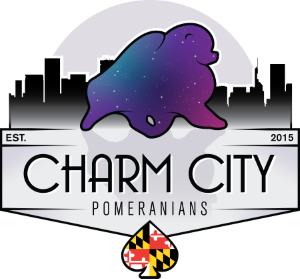Are merle pomeranians healthy? Are there any health concerns with merle pomeranians?
These are two very common questions I hear. Hopefully this page answers some questions, and points you in the right direction to do your own research.
Merle (heterozygous) pomeranians are not at risk of any health conditions that their non-merle counterparts may experience. It is important that any dog, of any color used in a program is health tested as prescribed by the parent club. It is also important that a breeder who uses merle dogs in their program understands how to safely and properly breed the gene. For pomeranians, a good place to start is the guidelines and code of ethics outlined by the American Pomeranian Club.
Although merle is one of the more popular coat patterns of dogs, it is not without controversy. Merle-to-merle matings can result in double merle (MM) offspring that have ocular (including blindness and microphthalmia) and auditory defects; this is possible even for merle-to-cryptic merle matings. We hope this work will raise awareness among breeders that there are merle varieties that do not fit the standard phenotypic description and that this knowledge will prevent undesirable matings and mischaracterizations. (ref: Sarah Murphy & Leigh Anne Clark, Clemson University)
What is a cryptic merle? A cryptic or phantom merle is a dog which phenotypically appears to be a non-merle (solid-colored) or a dog that has very faint patches of merle that can go unnoticed. Animals that do not present the merle phenotype may possess the merle genotype and subsequently produce merle offspring. These animals are known as cryptic merles, as they don't appear to be merle but can produce merles. (ref: Animal Genetics)
To reduce the possiblity of accidently having a double merle puppy, parents should be genetically tested for the merle gene. Merle is a dominate gene, and cannot be carried, however, if a puppy is born to a merle parent that does not have the visual merle pattern, it is important that the puppy be spayed or neutered, to prevent an accidental double-merle litter. Often a sable merle is born with a visual merle pattern, but the sable pattern overrides the merle pattern, and they often mature looking like a regular sable dog. A sable merle will not have the pretty mottled pattern generally associated with a merle dog. A merle should never be bred to a clear colored dog or a brindle pattern dog, as outlined in the APC Code Of Ethics.
Where did merle come from in Pomeranians? Was it introduced by crossbreeding? Well, in short, I am not sure. There have been many rumors about when and how the pattern was introduced, but we can find evidence that 'mottled' pomeranians were around in the 1920's. Here are some excepts from Dogs as Home Companions by A.F. Hochwalt, where he writes: "They come in all colors; black, sable white, blue mottled and in fact, in any shade imaginable. Indeed it has been said that the fashionable thing nowadays for ladies is to have a Pom of every shade to match their gowns..."
Are merle pomeranians more expensive? An ethical breeder is not charging more for puppies based on their coloring.
Merle Dogs - Breeds and Facts You Need to Know - Purina
Is merle an allowed color for pomeranians? Yes, merle is an acceptable pattern in America. US born merle pomeranians can be registered and shown in AKC Conformation. The American Pomeranian Club has good examples of merle pomeranians.




